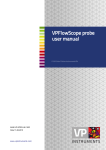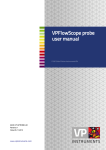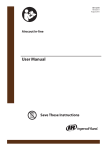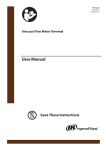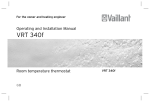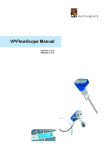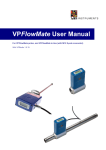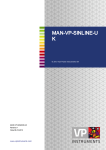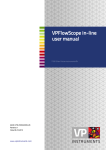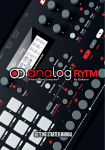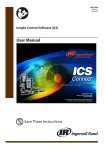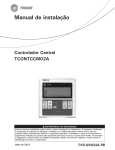Download User Manual - Ingersoll Rand
Transcript
49112501 Revision A August 2015 Airscout Flow Meter Insertion Probe User Manual Save These Instructions Table of contents 1.0 SAFETY INFORMATION . . . . . . . . . . . . . . . . 3 7.0 DISPLAY. . . . . . . . . . . . . . . . . . . . . . . . . . . . . . . 12 1.1 SAFETY SYMBOLS . . . . . . . . . . . . . . . . . . . . . . . . . 3 7.1 Display status icons. . . . . . . . . . . . . . . . . . . . 12 2.0 INTRODUCTION. . . . . . . . . . . . . . . . . . . . . . . 4 7.2 LCD display . . . . . . . . . . . . . . . . . . . . . . . . . . . . . . 12 3.0 Product overview. . . . . . . . . . . . . . . . . . 4 7.3 Data Logger. . . . . . . . . . . . . . . . . . . . . . . . . . . . . 12 7.4 Key pad. . . . . . . . . . . . . . . . . . . . . . . . . . . . . . . . . . . 12 3.1 Configuration. . . . . . . . . . . . . . . . . . . . . . . . . . 5 7.5 Menu. . . . . . . . . . . . . . . . . . . . . . . . . . . . . . . . . . . . . 12 3.2 Airscout probe with connector cap. . 5 8.0 AIRSCOUT STUDIO SOFTWARE. . . . . . . . . 14 3.3 Airscout probe with display. . . . . . . . . . . 5 9.0 ELECTRICAL CONNECTIONS . . . . . . . . . . . 15 3.4 Airscout Probe with the Airscout Terminal. . . . . . . . . . . . . . . . . . . . . . 5 9.1 4..20 mA output. . . . . . . . . . . . . . . . . . . . . . . . . . 15 4.0 QUICK START. . . . . . . . . . . . . . . . . . . . . . . . . . 6 9.2 Pulse output. . . . . . . . . . . . . . . . . . . . . . . . . . . . 16 5.0 MEASUREMENT . . . . . . . . . . . . . . . . . . . . . . . 6 9.3 Modbus interface . . . . . . . . . . . . . . . . . . . . . . 17 5.1 Flow. . . . . . . . . . . . . . . . . . . . . . . . . . . . . . . . . . . . . . 6 9.5 Connection to X-series controller. . . 20 5.2 Pressure. . . . . . . . . . . . . . . . . . . . . . . . . . . . . . . . . 7 10.0 SERVICE. . . . . . . . . . . . . . . . . . . . . . . . . . . . . .21 5.3 Temperature. . . . . . . . . . . . . . . . . . . . . . . . . . . . . 7 10.1 Recalibration. . . . . . . . . . . . . . . . . . . . . . . . . . 21 5.4 Totalizer. . . . . . . . . . . . . . . . . . . . . . . . . . . . . . . . . 7 11.0 SPECIFICATIONS . . . . . . . . . . . . . . . . . . . . . 21 6.0 MECHANICAL INSTALLATION. . . . . . . . . . 7 12.0 ORDER INFORMATION AND ACCESSORIES. . . . . . . . . . . . . . . . . . . . . . . . 22 6.1 Piping table. . . . . . . . . . . . . . . . . . . . . . . . . . . . . . 11 13.0 APPENDIX A -UL. . . . . . . . . . . . . . . . . . . . . . 23 49112501 Rev.A 1.0 SAFETY INFORMATION 1.1 SAFETY SYMBOLS Compressed air can be dangerous! Please familiarize yourself with the forces under pressurized conditions. Respect the local guidelines and regulations for working with pressurized equipment. Gas flow through pipes follows certain physical laws. These physical laws have serious consequences for the installation requirements. Familiarize yourself with these laws to make sure that the product is installed correctly. Always make sure that upstream length, downstream length, flow, pressure, temperature and humidity conditions are within specifications. Precision instruments need maintenance. Check your flow meter regularly and make sure it remains clean. When polluted, gently clean the sensor using demineralised water or cleaning alcohol. Airscout flow meters require calibration. Not intended for fiscal metering or billing. Our flow meters are not certified for fiscal metering. Laws on fiscal metering and billing may vary per country or state. Do not overestimate the results. Ingersoll Rand does not take any responsibility for the correctness of measurement results under field conditions. The practical measurement uncertainty of a flow meter in the field may vary, depending on how well it is installed, due to the nature of gas flow. The piping table provides guidelines on how to optimize the field accuracy. Our products are not intended to be used as a single means to determine compressor capacity. DO NOT OPEN Do not open the device. Our instruments are assembled with high precision. Opening this device is dangerous and may destroy the instruments. The IP rating might be compromised. Warranty is voided when you open the instrument. Feedback leads to product improvement. Please share your experience with us, as we are continuously improving our products in our commitment to quality, reliability and ease of use. 49112501 Rev.A 2.0 INTRODUCTION Congratulations! You purchased the easiest to use and most complete compressed air measurement tool in the world. With the Airscout probe, you can monitor and record flow, pressure, temperature, and total air consumption, simultaneously. Great products deserve great user manuals. We have done our best to make this user manual as complete as possible. New users, please read it carefully to familiarize yourself with our products. 3.0 Product overview The Airscout probe measures mass flow, temperature and pressure simultaneously. All these parameters are key to proper compressed air measurement and are therefore included in all models. With the insertion probe you are flexible in pipe diameter. All data can be accessed by Modbus RTU, 4..20 mA and pulse. The Airscout probe is available in two configurations to fit every application. Use the connector cap for sensor features only, ideal for integration into a central management system. Use the display module for central read out and data logging. For both models, all parameters and outputs remain available. Airscout Insertion Probe CCN Description 23158702 Air Scout Start Kit 23158744 400 mm Airscout with Display and Data Logger, M12 (5-Pin) connector 49099153 400 mm Airscout with Connector Cap, M12 (5-Pin) connector 49099161 600 mm Airscout with Connector Cap, M12 (5-Pin) connector All of the Airscout Insertion Probe flow meters listed above include bi-directional flow, safety chain and compression fitting. Order the Airscout starter kit to receive the complete start kit with all required accessories, everything you need to get 49112501 Rev.A started right away. All output parameters for remote connection remain available on the M12 connector. 3.1 Configuration The instruments needs only one step to be ready for operation. It needs to know the exact inner pipe diameter for accurate measurement, wrong inner diameter will lead to very significant errors. The pipe diameter can be programmed with the key pad on the display module or with the Airscout studio configuration software. This software suite is also used for configuration of the outputs and data logger. 3.2 Airscout probe with connector cap The Airscout probe with connector cap can be used in applications where local read-out and data logging is not required. With it’s various outputs the Airscout probe can be connected to remote data loggers. 3.3 Airscout probe with display The display module adds a 3 row display with key pad and an optional 2 Million point data logger to the Airscout probe. All parameters will be shown on the display in real time. The key pad can be used to start a data log session or to change the key parameters of the Airscout probe. 1. Menu / Enter button 4. Down button 2. Esc / Record button 5. LCD display 3. Up button 3.4 Airscout Probe with the Airscout Terminal The Airscout Terminal can be used as a remote display for situations where the local display can’t be read. All display features will be available on the remote display. The Airscout Terminal can be equipped with a 10m/32.8ft cable. The terminal can be connected to the Airscout insertion probe with connector cap via a M12 (8-pin) cable. The Airscout Terminal features a 2 million point data logger which extends the data log capacity of your Airscout insertion probe. 49112501 Rev.A 4.0 QUICK START • The sensor needs to be in the middle of the pipe. This chapter contains the basic steps to start using your Airscout probe flow meter. Additional information on all subjects can be found in the next chapters. • Tighten the compression fitting. 4. Electrical installation 1. Unpack 4.1 Permanent installation Unpack the meter and check if all items are there and in good shape. A checklist with all items is available on the box. Connect a cable with 5 Pin M12 connector to the Airscout probe. The cable can be connected to a central data acquisition / building management system or data logger via Modbus, 4..20 mA or pulse. Apply 12-24 VDC to power up the device. Use a Class II power supply (less than 2 Amps). If a display is available, it will light up when power is applied. 2. Program the settings • The inner pipe diameter needs to be programmed into the sensor. This can be done via the display or with the Airscout studio software • If required, set the output parameters for the Modbus, pulse and current output 4.2 Temporary installation 3. Mechanical installation • Find the best point of installation for this product. Make sure that all specifications are met. • For installation of the Airscout probe, an insertion point needs to be created. You can weld a tap with internal 1/2 inch thread. Use a 12 Volt power supply with M12 connector to power the Airscout probe. This quick method is ideal for audits. 5. Data recording When the display with data logger is available a data log session can be started by pressing the esc button and then enter. All parameters will be logged with the default logging intervals. These logging intervals can be changed with the Airscout studio software. This software tool is also used to retrieve the recorded sessions. • Place a ball valve and compression fitting on the insertion point. • Connect the safety chain and insert the probe into the pipe. 5.0 MEASUREMENT For all parameters the update interval is 1 second. Within this second, multiple samples are taken and averaged to provide a stable and reliable output. The Standard bi-directional sensitivity is shown in the figure below. The negative flow value will show up as a minus sign. The 4..20 mA value needs to be adapted to suit the application. 5.1 Flow The Airscout probe uses our proprietary insertion type thermal mass flow sensor. There is no bypass flow, which results in a high robustness and less sensitivity for dirt or particles. The flow sensor is directly temperature compensated. No flow Everything in balance. The sensor response signal is directly related to the mass flow rate and can be described by the following formula: Flow from left The left part is cooled down; the right part of the bridge is heated up. Vout=k *λ* ρ*v* (Ts-Tg) Vout = output voltage k = sensor (geometrical) constant λ = thermal conductivity of the gas ρ = density of the gas v = actual velocity in m / sec Ts = sensor temperature Tg = gas temperature Flow from right Vice versa! Now the left part is heated up and the right part is cooled down. 49112501 Rev.A 5.2 Pressure For optimal measurement performance, the Airscout probe needs to be in a stable temperature environment. When exposed to quick temperature changes or large temperature changes (for example taking the unit from outdoor to indoor during winter time, or when mounted downstream of a heat regenerated drier) the temperature compensation may lag behind, which may result in significant measurement errors. The Airscout probe features a built-in gauge pressure sensor. The sensor range is 0...250 psi, rounded off this equals 0...16 bar gauge. The sensor cannot measure vacuum, please contact us if you have a vacuum application. The sensor membrane can handle media which are compatible with glass, silicon, stainless steel, Sn/Ni, plating and An/Ag solder. 5.4 Totalizer The sensor signal is sampled with 16 bits. The practical resolution is 0.24 mbar on the 0..16 bar scale, which is equal to 0.004 psi on the 250 psi scale The totalizer keeps track of the total consumed amount of compressed air in normal cubic meters, or in scf depending on which unit you choose to read out. The refresh interval is 1 second, actual measurement data will be available on the display and by Modbus. For back up reasons, the totalizer value is written to it’s internal memory with an interval of 15 minutes. A power down might result in maximum 15 minutes of totalizer data loss. 5.3 Temperature The built in temperature sensor measures the compressed air/ gas temperature. It is mounted in a separate position, to ensure quick response time and low self-heating of the sensor element. The signal is sampled with 16 bits. The resolution is less than 0.1 ˚C. In bi-directional operation, negative flow is subtracted from the totalizer. The totalizer will count backwards as the compressed air is delivered back to the supply side. The totalizer can only be reset to zero. It’s not possible to set it to a different value. In a vertical pipe, with flow going down, the temperature sensor may heat up at zero flow conditions, due to the heated flow sensor element. This effect will disappear as soon as there is consumption. 6.0 MECHANICAL INSTALLATION Put together the Airscout probe Connect the display or connector cap on the Airscout probe sensor module. Make sure that it slides completely over the O-ring seal. Position the O-ring in the upper position for the connector cap. Use the lower position for the display. Apply some O-ring grease if required. Gently fix the screw on top. • Potential water damage on the outside. Avoid areas of high humidity and avoid dripping. Be aware that the Airscout probe is not watertight, it is only IP65 (when mated with the USB protection cap). Install the Airscout probe in the pipe First select the right installation point. The installation point is crucial for the right measurements. Sources of error can be: installation effects, unknown flow profiles, swirls, pressure and temperature effects, humidity effects, oscillations in the flow. To ensure the highest possible accuracy of flow measurement, the installation and piping instructions must be followed carefully. Therefore read this paragraph carefully. • Mechanical vibration and danger (walking bridges, fork lift trucks). • Corrosive atmosphere where possible. • Electrical problems (high voltage/ high power). • Any source of potential error. WARNING These devices are only for use with Air, Nitrogen, Argon, Helium, Carbon Dioxide and other non hazardous, or non combustible gases. The maximum working pressure is 16 bar (250 psi) Take into account: • Choose a site which is accessible, which allows ease of wiring and maintenance, and which allows you to still read and access the display if possible. Prepare the installation • Meet the specifications of the Airscout probe. If the specifications are not met, for instance the pressure or temperature level is too high; this will cause inaccurate flow measurement and can even damage your flow meter. Use a ball valve to insert and retract the Airscout probe when you want. Use a 1/2 inch full bore ball valve or a 3/4 inch ball valve. The Airscout probe can be inserted through a welding coupling with internal 1/2 inch thread. WARNING • Do not apply mechanical stress on the sensor head. Make sure that the hole is at least 16 mm inner diameter, and completely clear for insertion. A too small hole will damage the probe or your measurement value will be very low. Avoid: • Excessive heat, check the temperature range of your Airscout probe. 49112501 Rev.A The installation Insertion depth Generally the insertion depth of the Airscout probe is 0.5 times the inner pipe diameter, where the bottom of the sensor tip must be in the middle of the pipe (see picture). SAFETY FIRST: START WITH MOUNTING THE SAFETY LINE! The Airscout probe is mounted with a 1/2 inch compression fitting. The probe is sealed with a Teflon ferrule instead of a stainless steel ferrule. Teflon may become slippery. The safety line will keep the sensor secure when it accidentally moves out of the compression fitting. NEVER over-tight the fitting, because it might damage the sensor tube. The Airscout probe is shaped to make alignment with the flow direction easy. Alignment “by the eye” is sufficient. See installation note on Figure 1. Exception Between pipe sizes of 1” and 2”: be aware that the field accuracy is +/- 10%; installation errors are bigger. Airscout in-line is recommended for application up to 2”. Troubleshooting Humidity (thermal sensors) Avoid condensation: use gravity! Bad practice Good practice Flooding: Pressure sensor over-reading Pressure sensor gets clogged over time Gravity helps to keep the sensor clean Figure 1 49112501 Rev.A Basic installation steps 1. Insert the compression fitting in the welding tap. Use Teflon tape or liquid sealant. 2. Keep the ball valve closed! 3. Insert the Airscout probe. 4. Mount the safety line. Hook the safety line up in the ring of the Airscout probe. For extra safety, you can add a luggage strap (like for suitcases). 49112501 Rev.A 5. Place a mark on the probe, to identify the place where it is safe to close the ball valve when retrieving the Airscout probe. 6. Open the ball valve and slowly push the Airscout probe completely in. 7. Push the probe in till it hits the bottom of the pipe. Now place another mark on the probe. 8. Retrieve the probe half the pipe diameter. Adjust the safety line (and strap) to keep the Airscout probe in place. Keep in mind to align the Airscout probe with the flow direction. 9. Gently tighten the compression fitting. Do not over tighten to prevent damage to the probe. Pull the probe to check if the compression fitting is tight enough. 10. Now your Airscout probe is installed. 10 49112501 Rev.A 6.1 Piping table The following table provides a guideline for proper distances between upstream or downstream objects and the Airscout probe. The upstream length is the length between the last non-straight object and the Airscout probe. If the upstream length is straight, and the distortion is downstream of the Airscout probe, you can use the column “downstream length” as a guideline. In very complex situations, with multiple up- and downstream objects, you should consider another location. This table is a practical guideline and is not exact science. Practical situations can have multiple sources of distortion, therefore Ingersoll Rand does not take any responsibility for the correctness. At least 20 times the pipe diameter upstream and at least 5 times the pipe diameter downstream needs to be applied, to avoid any distortion of the flow profile. Gas flow in pipes follows certain rules, which must be observed for optimal measurement results. For some exceptions the upstream length needs to be longer, or can be shorter. Check the piping table below for your application. Example: Pipe diameter - 4” 80” upstream of flow meter, 20” downstream If possible, you can always choose a longer upstream length, as these are minimum values. The up- and downstream lengths are used industry wide as guidelines, but will never be a guarantee for obtaining the “true value”. So always be careful and try to build up your own experience from practical measurements Picture 49112501 Rev.A Upstream length Downstream length Complex feed-in situation (header) 40 * D1 10 * D1 Flow profile will be distorted Double elbow, multiple elbows following each other 40 * D1 10 * D1 Distorted profile + swirl Diameter change from small to large (gradual or instant) 40 * D1 5 * D1 Jet shaped flow Diameter change from large to small (gradual change, between 7 and 15 degrees) 10 * D1 5 * D1 Flattened flow profile Single elbow 30 * D1 10 * D1 Distorted flow profile Description Effect 11 7.0 DISPLAY The display module unlocks some new cool features! When a power failure occurs during recording, the session will be stopped. When power is restored, a new session will start automatically. • LCD display with 3 lines of real time data, refreshed every second • Key pad with menu to configure the main settings 7.4 Key pad • Data logger with adjustable logging intervals The key pad contains 4 buttons to control the display. 7.1 Display status icons Some status icons show feedback on the meters’ status. Below is a list with explanation. Icons Description Sensor module is properly connected and supplied with power No communication with the sensor [Check external power when disconnected] 1 A blinking dot will indicate that a data session is active 2 2 rotating arrows indicate that there is communication with the computer 3 The display is locked. The menu can not be accessed 4 Memory indication. Each block indicates 20% of memory usage. The blocks start to blink if the memory is more then 95% full Special key functions • Lock display In the main screen, press up and down simultaneously to lock or unlock the display. A lock icon will appear in the right lower corner of the screen. The lock function will block key pad functionality. 7.2 LCD display The LCD display provides 3 rows for real time data. Each row can be configured in the menu by selecting the desired parameter for this row. • Clean re-boot. 7.3 Data Logger Hold esc pressed when turning the power on. Use this option when a display will not start up or if a session won’t stop. This can happen due to subsequent power failures at the moment that the memory is almost full. The built-in data logger offers you 2 Million data points. Enough to measure all three channels 1 x per second for more than a week. A little warning though: more data does not always lead to better insight in savings! 7.5 Menu Use the following guidelines for the intervals Application The menu is categorized into 3 main items which contain their own sub menu items. The complete menu structure is shown below: Flow Pressure Temperature 5 min Standard energy management application 5 min Machine testing -quick fluctuations 1 sec 1 sec 1 sec Audit -one week 10 sec 10 sec 5 min Audit -one month 30 sec 30 sec 5 min 5 min 1. Settings 1. Display 2. Date and Time 3. Modbus address 4. Display dim time Multiple sessions can be recorded. When a session is started, a separate session will be recorded. It’s not possible to append to an existing session. 12 Menu / Enter Used to enter the (sub) menu or to confirm a setting Escape / Will start a data logging session Record when in the data acquisition screen. Will return from a (sub) menu when not in the data acquisition screen Button Navigate down in the menu down Button up Navigate up in the menu 5. Display orientation 2. DAQ Sessions 49112501 Rev.A 1. New Session The Modbus address can be changed with this option. Use the up and down buttons to change the number. Available numbers 1 – 247. 2. Delete all 3. Advanced After setting the number press enter to save the address. The power of the Airscout probe needs to be cycled to activate the new address. 1. Reset 1. Settings 1.4 Display dim time The settings menu can be used to change both functional parameters as display settings. The display backlight dim time can be adjusted here. The default dim time is set to 10 seconds. Other Available options are: 1.1 Display The main screen of the display contains 3 rows to display measurement values. Via this menu measurement values can be assigned to these rows. Available options in the menu are: Measurand Available units Empty - Flow Pressure Temperature Totalizer • Fading off. The backlight will remain on. • 5 till 30 seconds with steps of 5 seconds. Confirming with menu will make this setting immediately active. Description 1.5 Display orientation Leave this display row empty Normalized mn/sec m3n/h ln/min CFM m3/min sfps Bar Psi ˚C ˚F m3n The text on the display can be set upside down for installations were the Airscout probe is installed in this way. Enter the menu item and select the desired orientation with the arrow keys. Confirm with enter to make these settings active. All keys will maintain their function. 2. DAQ Sessions Gauge Custom The Airscout probe display contains an optional 2 million point data logger. When equipped, the menu is set to start and stop the sessions or to delete all present data. Normalized 2.1 Start session 5 available units to be configured with Airscout studio. Multiply an existing unit with a user defined factor. The session will be started when you push the enter button after selecting this option. When the session is started, the menu will close and the main screen will be shown. A blinking dot in the right upper corner will indicate the running session. The menu will be blocked when a session is active. The session can be stopped by pressing the esc button. 1.2 Date and Time Adjust date and time settings. First enter the menu option and set the date with the key pad. The date is formatted as: DD-MM-YYYY. After setting the date, confirm with enter and then enter the time settings in format: HH:MM:SS, again confirm with enter. The new date will become active immediately. 2.2 Delete all All sessions will be deleted. It is not possible to delete just a single session. 3 Advanced 3.1 Reset Date/time settings are kept actual by the real time clock until long power down. Date and time will also be synchronized with the computer when used with Airscout Studio. Reset the device. All peripherals will be re initialized. This option is also needed when updating the display firmware. 1.3 Modbus address 49112501 Rev.A 13 8.0 AIRSCOUT STUDIO SOFTWARE Configure the Airscout probe The Airscout probe can be read out and configured with the Airscout studio software. • Start the Airscout studio software In case of basic configuration and read out, use the free edition. If real time logging is required, registration keys are available for purchase. • In the left white window, right click to open the menu. Now click add device • Click the scan button to search for the right COM port. Select it and click add A quick start is shown below. • Enter a name for the device WARNING • Now select serial for RS485 converter or USB if the meter is connected with USB The sensor module needs to be connected to the displaying order to read out the display. It is not possible to read out sessions when the Airscout probe sensor is not connected. • Set the communication parameters if available • Click add. Connect the Airscout probe to the computer Airscout probe sensor read out The Airscout probe can be connected to the computer with the M12 connector through the JB5 interface box. This interface box combines the power and data signals. Power up the device by connecting the 12VDC power supply to the JB5 interface box. An RS485 to USB converter can be used to connect the JB5 interface box to the computer. • Click on the device in the explorer window to read out the settings • The status tab provides general information • The installation tab is used to configure the settings Airscout probe display read out [option] Install USB drivers • Click on the plus icon to unfold the display icon Install USB converter driver A driver needs to be installed for the RS485 to USB converter. The driver might be installed automatically by your windows system or need to be installed manually. • Click on display to read out the display settings • The status tab provides general information • The installation tab is used to configure the settings • Click sessions below display to retrieve session data. 14 49112501 Rev.A 9.0 ELECTRICAL CONNECTIONS Tip: Use a shielded cable of good quality to connect the meter. Connect shield to safety ground on one point. For portable, non-critical applications, a switched mode 12 V DC, 1A power adapter may be used. Switched mode power supplies that are of poor quality, might affect the accuracy. WARNING NEVER USE AC POWER. THIS WILL VOID WARRANTY AND BRING PERMANENT DAMAGE TO THE ELECTRONICS. THE INSTRUMENT MIGHT BE DAMAGED BEYOND REPAIR. CONNECT THE M12 CONNECTOR BEFORE POWERING UP THE INSTRUMENTS. 2 3 Pin Signal Flow mn/sec Flow m3n/hr Flow ln/min Flow SCFM Flow m3n/min Flow sfps Pressure bar Pressure psi Temperature ˚C Temperature ˚F Mode Zero Span Idle output Single direction 0% flow range 100% flow range 4 mA Bi-directional -100% flow 100% flow range range 5 4 Unit For scaling purposes, the zero and span matching 4 and 20 mA can be modified. This will not effect the original measurement range. The zero and span are only used to increase or narrow the resolution. For bi-directional measurement, the zero value needs to be set negative. See below table for factory defaults. The Airscout probe provides a 4..20 mA / pulse output and a Modbus output. All signals are present in the M12 connector. These outputs can be used to connect the Airscout probe to a building management system or energy monitoring system. 1 Measurand 12 mA Configuration with Airscout studio Airscout studio has graphical visualization for the 4..20 mA settings. The actual settings will be shown next to the factory settings. Wire color 1 +12...24 VDC Brown 2 0 Volt White 3 4..20 mA signal, active Blue 4 RS485 A Grey 5 RS485 B Black With Airscout studio, in the pull down menu, you can choose above units to assign to the output. Adjust the zero and span for scaling. Changing to volumetric units, the programmed diameter is calculated in the settings. So change the diameter first, then the analogue settings. Airscout studio provides feedback while you are changing the settings. Use “set default” to go back to the factory default. 9.1 4..20 mA output The 4..20 mA output is an active, non-isolated linearized output that can be used to connect the Airscout probe to a control system, a building management system or any 4..20 mA based SCADA system. There is one 4..20 mA output available on the Airscout probe. This output can be assigned to one of the measurement parameters, only one can be selected. For each measurand, a number of units is available. The factory default is mn/sec. 49112501 Rev.A 15 4..20 mA output Single direction Bi-directional mA mA 25.0 25.0 20.0 20.0 15.0 15.0 10.0 10.0 5.0 5.0 0.0 0.0 0 50 100 150 -100 200 -50 0 50 100 mn/sec mn/sec 0% | 100% flow -100% | 100% flow Electrical scheme: The current meter is placed in between the current output and the power supply ground. You can also use a digital multi meter to test the current output. of continuous negative flow, consider to swap the flow meter direction. 9.2 Pulse output The Airscout probe features a low-frequency active pulse output. The pulse is a ‘non potential’ free output as it acts like a controlled current output. To make it passive, an external isolator can be used. The pulse interval can be set with the Airscout studio software. A pulse from 0..20 mA will be generated when the interval exceeds. The maximum pulse frequency is once per 2 seconds. If the pulse interval is set to small, a continuous pulse (20 mA high level) will be the result. Diameter Pulse interval > 40 mm and < 92 mm > 1.57 inch and < 3.62 inch 1 m3n > 92 mm and < 160 mm > 3.62 inch and < 6.3 inch 2 m3n > 160 mm and < 205 mm > 6.3 inch and < 5 m3n 8.07 inch Pulse output mA 25.0 The pulse output is connected to the internal totalizer value. When the totalizer has increased by the pulse interval, the pulse will be generated. As it is not possible to generate a negative pulse, negative flow can not be indicated by pulse. In case of negative flow, the internal totalizer will count backwards. Pulses will not be generated until the same amount of positive flow has been added to the totalizer again. In this way we ensure that the pulse output will always be synchronized with the internal totalizer of the Airscout probe. In case 16 Diameter 20.0 15.0 10.0 5.0 0.0 0 1 2 3 4 5 6 7 8 Time (sec) 49112501 Rev.A Electrical scheme: 9.3 Modbus interface Introduction to Modbus Communication settings For new users, a complete introduction on the Modbus standard can be found on www.modbus.org. See the document Modbus_over_serial_line_V1_02.pdf, which can be downloaded from their website. We strongly recommend to download and read this information carefully. The RS485 communication settings can be changed with Airscout studio. Below shows the available options The Airscout probe can be used in multidrop Modbus networks. Upto 247 Airscout inline’s can be placed into one daisy chain. However, due to bandwidth restrictions we recommend to split up daisy chains. For a data polling rate of once per second, the maximum number of Airscout probe’s is 8, when flow, pressure, temperature and totalizer are read out. The Modbus settings can be changed with Airscout studio, the hardware address can also be changed with the key pad when available. Below shows all available options All measurement parameters are available through Modbus in floating point and integer format. The data will be refreshed every second. Maximum polling interval is 10ms. Data format Function code 0x03 for reading (Holding register) Function code 0x10 for writing (Holding register) 32-bit Floating point Little endian 32-bit signed Integer Little endian • Baud rate: 9600 | 19200 | 38400 • Stop bits: 1 | 2 • Parity: None | Even | Odd • Hardware address: 1-247 • Integer multiplier: 1-1000 Placing multiple devices in a multidrop network will cause voltage drops. The minimum supply voltage is 12VDC. In networks with more then 8 devices or longer then 200 meter, ask your local contractor for advice. 49112501 Rev.A Register map The actual measurement data is placed in holding registers. To read out data, you will need to use the corresponding holding register. All data is stored in 2 16bit registers with below register number as start address. 17 Read out the data with this start address and length 2. Decimal HEX Description Type Read / Write 16 17 18 19 20 21 0x10 0x11 0x12 0x13 0x14 0x15 Flow in mn/sec Flow in m3n/hr Flow in ln/min Flow in SCFM Flow in m3n/min Flow in sfps 32-bit integer (x10) 32-bit integer (x10) 32-bit integer (x10) 32-bit integer (x10) 32-bit integer (x10) 32-bit integer (x10) Read Read Read Read Read Read 32 33 0x20 0x21 Pressure in bar Pressure in psi 32-bit integer (x10) 32-bit integer (x10) Read Read 64 65 0x40 0x41 Temperature in ˚C Temperature in ˚F 32-bit integer (x10) 32-bit integer (x10) Read Read 128 8 9 10 11 0x80 0x08 0x09 0x0A 0x0B Totalizer in m3n Diameter 4..20 mA Max 4..20 mA Min 4..20 mA Unit 32-bit integer (x10) 32-bit Floating point 32-bit Floating point 32-bit Floating point 32-bit Floating point Read / Write* Read Read / Write Read / Write Read / Write 24 25 26 27 28 29 0x18 0x19 0x1A 0x1B 0x1C 0x1D Flow in mn/sec Flow in m3n/hr Flow in ln/min Flow in SCFM Flow in m3n/min Flow in sfps 32-bit Floating point 32-bit Floating point 32-bit Floating point 32-bit Floating point 32-bit Floating point 32-bit Floating point Read Read Read Read Read Read 40 41 0x28 0x29 Pressure in bar Pressure in psi 32-bit Floating point 32-bit Floating point Read Read 72 73 0x48 0x49 Temperature in ˚C Temperature in ˚F 32-bit Floating point 32-bit Floating point Read Read 136 0x88 Totalizer in m3n 32-bit Floating point Read / Write* * Writing to the totalizer will reset the totalizer to zero. Available write operations 18 Option Data Description 4..20 mA unit 0 1 2 3 4 5 6 7 8 9 Other mn/sec m3n/hr ln/min SCFM m3n/min sfps bar psi °C °F mn/sec 4..20 mA min Decimal value 4..20 mA max Decimal value Totalizer Integer or floating point type depending on register type Will reset the totalizer to zero 49112501 Rev.A Electrical scheme: For a one-to-one connection with a PLC or a different type of RS485 converter, please see the wiring scheme below. When short wiring is used, a termination resistor is not needed. For longer wires (>10 m), please read RS485 related literature. The ground (common) should be connected to the read out device, so you will need three wires to establish the connection. Modbus chain: If multiple Modbus devices are connected in one chain, the configuration as shown below needs to be used. The trunk line goes from the master to all devices making a drop down to each device. The cable length from the trunk line to the Modbus device needs to be as small as possible. Junction boxes are used to make the T junction. The end of the trunk line needs to be terminated with a 120 Ohm resistor. This termination is easily made with the jumper switch and pre-installed resistor inside the junction box. WARNING: make sure that only ONE termination resistor is active and all others are inactive, otherwise the Modbus power consumption will dramatically increase and the signal will be lost. + 12..24 VDC 0 Volt A B Junction Box 4-20+(not required) A B 12..24 VDC 0V 5 meter, 5 wire shielded cable with moulded M12 Default color scheme Modbus connector With M12, 5 Pin Pin assignment Identical to Airscout display module 49112501 Rev.A 19 9.5 Connection to X-series controller The correct wiring configuration consists of two steps: A.Provide power to the flow meter from an available terminal on the I/O Box PSU24 power supply. There are three 24VDC terminals available on the PSU24 - XO2, X03 and X04. Connect the brown wire from flow meter to +24VDC from an available port on the PSU24. Connect the white wire on the Flow meter cable to 0VDC from the same port. See below Figure. Connect the wires from Flow meter to one of these terminals, Brown to +24DC and white to 0VDC B. Connect the blue wire from the Row meter cable to the desired analog input signal terminal on the I/O Box terminal PSB board. Located ports 32,34,36 or 38 shown in figure 2. Connect the blue wire from the flow meter to analog input signal terminal. Use parts 32, 34,36 or 38. Once wiring is complete, the analog input can be properly scaled to provide proper operation. Use values from the IR Calculator as inputs. Refer to lngersoll Rand I/O Box manual for instructions on how to input these values. 20 49112501 Rev.A 10.0 SERVICE 10.1 Recalibration The Airscout probe needs regular maintenance to ensure that the product is functioning properly. Especially when the product is used for mobile air audits, we recommend inspecting the instrument before and after every audit to ensure that the product has not been damaged. For precision measurement equipment such as the Airscout probe, a proper maintenance program is key to reliable measurement results and a long product lifetime. To keep your Airscout probe in best shape, it needs recalibration. The recommended recalibration date can be found in Airscout studio, when you read out your Airscout probe. Keep close eye on this date. We advice annual recalibration. 11.0 SPECIFICATIONS Please always check the label of your product for the specifications. Specifications are subject to change as we are continuously improving our products. Please contact us to obtain the latest specification sheet. Flow sensor (minimum detection level and max flow rate shown) Flow range 0.5...150 mn/sec Accuracy 2% of reading under calibration condition Recommended pipe diameter: 40 mm | 1.5 inch and up Reference conditions 0 °C, 1013.25 mbar -DIN1343 Gas temperature 0....60 °C Gases Compressed air, nitrogen, inert gases, 95% non condensing gases Pressure sensor Range 0...16 bar gauge Accuracy +/-1.5% FSS (0...60 °C) Temperature sensor Range 0....60 °C Accuracy +/-1° (from 10 mn/sec and up) (At zero flow conditions, temperature reading increases due to self-heating by the flow sensor) Display Technology Liquid crystal Back light Blue with auto power save Memory 2 Million point memory option Mechanical Probe length Probe diameter Process connection Pressure rating IP grade 400 mm 12.7 mm Compression fittings, 0.5 inch, NPT thread PN10, PN20: See product label IP52 when mated to display module IP63 when mated to connector cap Alu, SS316, epoxy 0..60 °C 10 -95%. Avoid condensation at all times Wetted materials Ambient temperature Ambient humidity Inputs and outputs Serial IO Modbus RTU Supply 12..24 VDC +-10% CLASS 2 (UL) Power consumption 150 mA at 24 VDC 0…250 psi gauge +/-1.5% FSS (32..140 °F) 32…140 °F 32 .. 140 °F 4..20 mA or pulse, selectable via installation software 32 °F, 14.65 psi 32..140 °F 15 inch 0.5 inch Analog 49112501 Rev.A 1.7…492 sfps 21 12.0 ORDER INFORMATION AND ACCESSORIES Airscout Insertion Probe CCN Description 23158702 Air Scout Start Kit 23158744 400 mm Airscout with Display and Data Logger, M12 (5-Pin) connector 49099153 400 mm Airscout with Connector Cap, M12 (5-Pin) connector 49099161 600 mm Airscout with Connector Cap, M12 (5-Pin) connector Insertion Probe Replacement Parts and Accessories 23808967 Cable, 10 m / 32.9 ft with M12 5-pin connector on one side, open wires on other side 49099245 Power supply ( 12V, 5-pin ) 23132913 RS485 to USB converter 49099252 JB5 interface box with 5m / 16.4ft cable + 12 VDC power supply 23500820 Replacement insersion probe (probe only) 23500846 Connector cap with M12 5-pin socket 23132806 Display with data logger 49099179 Safety chain 49099187 Compression fitting, 0.5” NPT 49099195 Replacement Teflon ferrules for compresion fitting (5) 23771991 Air Scout Explorer Case 39105747 0.75” M-F Ball Valve Terminal and Accessories 22 23818065 Terminal wall-mount display with cable and power supply 49099260 Connector cap with M12 8-pin socket 49099302 Replacement cable, 10m / 32.9 ft with M12 8-pin connector on one side, open wires on other side 49099310 Replacement Power supply, 1.9m / 6.3 ft, VS power plug on one side, open wires on other side 49112501 Rev.A 13.0 APPENDIX A -UL The Airscout complies with the CE requirements as stated in the CE declaration. CE compliance can only be achieved when grounding and shielding directions are followed and proper cables and connector assemblies are used. Electrical connection guidelines- UL 508 Listing for USA & Canada (Check label to see if product is UL marked) The Airscout is intended to be used with a Class 2 power source or Class 2 transformer in accordance with UL1310 or UL1585. As an alternative a LVLC (Low Voltage Limited Current) power source, with the following properties can be used: • The device shall be used with a suitable isolating source such that the maximum open circuit voltage potential available? to the product is not more than 24 VDC and the current is limited to a value not exceeding 8 amperes measured after 1 minute of operation; • A fuse in accordance with the UL248 series and rated max 4A, shall be installed in the 24VDC power supply to the device? In order to limit the available current. Electrical connection guidelines: general remarks Make sure that the following conditions are met: • For portable, non-critical applications, a switched mode 12 VDC, 1A power adapter may be used. Switched mode power supplies that are of poor quality, might affect the accuracy. Le Airscout est conforme aux exigences CE, comme indiqué dans la déclaration CE. La conformité CE ne peut être atteinte que lorsque les directives de mise à la terre et d’isolation sont suivies et que les les câbles et raccords appropriés sont utilisés. Lignes directrices pour branchements électriques – UL508 pour le Canada et les États-Unis (voir sur l’étiquettesi le produit est marqué UL) Le Airscout est prévu pour être utilisé avec une source d’alimentation Classe 2 ou avec un transformateur de Classe 2 en accord avec UL1310 ou UL1585. Comme alternative, une source d’alimentation BTCL (Basse Tension Courant Limité) avec les propriétés suivante peut être utilisée : • Le dispositif doit être utilisé avec une source d’isolation appropriée afin que le voltage maximal en circuit ouvert disponible pour le produit ne dépasse pas 24VDC, et que le courant soit limité à une valeur de 8 ampères après 1 minute de fonctionnement. • Un fusible de 4Amaximum, et conforme à la série UL248 doit être installé dans la source d’alimentation de l’appareil afin de limiter le courant disponible. Directives pour le raccordement électrique : remarques générales Assurez-vous que les conditions suivantes sont remplies : • Pour les applications mobiles, un adapteur de type alimentation à découpage 12VDC, 1Apeut-être utilisée. Cependant, un adapteur de mauvaise qualité pourra affecter la précision. 49112501 Rev.A 23 ingersollrandproducts.com © 2015 Ingersoll Rand
























